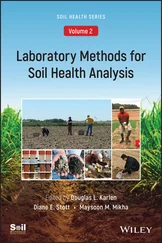Soil Health Analysis, Set
Здесь есть возможность читать онлайн «Soil Health Analysis, Set» — ознакомительный отрывок электронной книги совершенно бесплатно, а после прочтения отрывка купить полную версию. В некоторых случаях можно слушать аудио, скачать через торрент в формате fb2 и присутствует краткое содержание. Жанр: unrecognised, на английском языке. Описание произведения, (предисловие) а так же отзывы посетителей доступны на портале библиотеки ЛибКат.
- Название:Soil Health Analysis, Set
- Автор:
- Жанр:
- Год:неизвестен
- ISBN:нет данных
- Рейтинг книги:3 / 5. Голосов: 1
-
Избранное:Добавить в избранное
- Отзывы:
-
Ваша оценка:
- 60
- 1
- 2
- 3
- 4
- 5
Soil Health Analysis, Set: краткое содержание, описание и аннотация
Предлагаем к чтению аннотацию, описание, краткое содержание или предисловие (зависит от того, что написал сам автор книги «Soil Health Analysis, Set»). Если вы не нашли необходимую информацию о книге — напишите в комментариях, мы постараемся отыскать её.
Soil Health Analysis, Set — читать онлайн ознакомительный отрывок
Ниже представлен текст книги, разбитый по страницам. Система сохранения места последней прочитанной страницы, позволяет с удобством читать онлайн бесплатно книгу «Soil Health Analysis, Set», без необходимости каждый раз заново искать на чём Вы остановились. Поставьте закладку, и сможете в любой момент перейти на страницу, на которой закончили чтение.
Интервал:
Закладка:
42 McDaniel, M. D., Tiemann, L. K., & Grandy, A. S. (2014). Does agricultural crop diversity enhance soil microbial biomass and organic matter dynamics? A meta‐analysis. Ecological Applications, 24(3), 560–570. https://doi.org/10.1890/13‐0616.1
43 Moebius, B. N., van Es, H. M., Schindelbeck, R. R., Idowu, O. J., Thies, J. E., & Clune, D. J. (2007). Evaluation of laboratory‐measured soil properties as indicators of soil physical quality. Soil Science, 172, 895–912. https://doi.org/10.1097/ss.0b013e318154b520
44 Montgomery, D. R. (2007). Dirt: The erosion of civilizations. Berkley, CA: University of California Press.
45 National Research Council. (1993). Soil and water quality: An agenda for agriculture. Washington, DC: National Academic Press.
46 Norris, C. E., Bean, G. M., Cappellazzi, S. B., Cope, M., Greub, K. L. H., Liptzin, D., Rieke, E. L., Tracy, P. W., Morgan, C. L. S., & Honeycutt, C. W. (2020). Introducing the North American project to evaluate soil health measurements. Agronomy Journal. https://doi.org/10.1002/agj2.20234
47 Nutrien Ltd. (2018). Nutrien Announces Agreement to Purchase Waypoint Analytical, a Leading U.S. Agricultural Lab and Soil Science Company. https://www.prnewswire.com/news‐releases/nutrien‐announces‐agreement‐to‐purchase‐waypoint‐analytical‐a‐leading‐us‐agricultural‐lab‐and‐soil‐science‐company‐300677498.html(verified 13 July 2020).
48 Pankhurst, C. E., Doube, B. M., & Gupta, V. V. S. R. (1997). Biological indicators of soil health: Synthesis. In C. E. Pankhurst, B. M. Doube, & V. V. S. R. Gupta (Eds.), Biological indicators of soil health (pp. 419–435). New York: CAB International.
49 Paustian, K., Lehmann, J., Ogle, S., Reay, D., Robertson, G. P., & Smith, P. (2016). Climate‐smart soils. Nature, 532(7597), 49–57. https://doi.org/10.1038/nature17174
50 Renard, K. G., Yoder, D. C., Lightle, D. T., & Dabney, S. M. (2011). Universal soil loss equation and revised universal soil loss equation. In R. P. C. Morgan & M. A. Nearing (Eds.), Handbook of erosion modelling (pp. 137–167). Oxford, UK: Blackwell Publishing.
51 Schjønning, P., Elmholt, S., & Christensen, B. T. (2004). Soil quality management– Concepts and terms. In P. Schjønning, S. Elmholt, & B. T. Christensen (Eds.), Managing soil quality: Challenges in modern agriculture (pp. 1–15). Wallingford, UK: CABI Publishing.
52 Singh, B. K., Millard, P., Whiteley, A. S., & Murrell, J. C. (2004). Unravelling rhizosphere–microbial interactions: Opportunities and limitations. Trends in Microbiology, 12(8), 386–393. https://doi.org/10.1016/j.tim.2004.06.008
53 Stott, D. E., Andrews, S. S., Liebig, M. A., Wienhold, B. J., & Karlen, D. L. (2010). Evaluation of β‐ glucosidase activity as a soil quality indicator for the soil management assessment framework (SMAF). Soil Science Society of America Journal, 74, 107–119. https://doi.org/10.2136/sssaj2009.0029
54 Sustainability Reports. (2019). 86% of S&P 500 Index Companies Publish Sustainability / Responsibility Reports in 2018. https://www.sustainability‐reports.com/86‐of‐sp‐500‐index‐companies‐publish‐sustainability‐responsibility‐reports‐in‐2018/
55 Tilman, D. G. (1998). The greening of the green revolution. Nature, 396, 211–212. doi:10.1038/24254
56 Turmel, M. S., Speratti, A., Baudron, F., Verhulst, N., & Govaerts, B. (2015). Crop residue management and soil health: A systems analysis. Agricultural Systems, 134, 6–16. https://doi.org/10.1016/j.agsy.2014.05.009
57 USDA‐ARS. (2015). Revised Universal Soil Loss Equation, Version 2 (RUSLE2). USDA National Soil Erosion Research Laboratory. https://data.nal.usda.gov/dataset/revised‐universal‐soil‐loss‐equation‐version‐2‐rusle2(verified 12 June 2020).
58 USDA‐ARS. (2017). Water Erosion Prediction Project (WEPP). USDA Agricultural Research Service. Washington, DC. https://data.nal.usda.gov/dataset/water‐erosion‐prediction‐project‐wepp(verified 12 June 2020).
59 USDA‐ARS. (2018). Wind Erosion Prediction System (WEPS). USDA ARS Engineering & Wind Erosion Research Unit. Washington, DC. https://data.nal.usda.gov/dataset/wind‐erosion‐prediction‐system‐weps(verified 12 June 2020).
60 USDA‐NRCS. (2019a). The Basics of Addressing Resource Concerns with Conservation Practices within Integrated Soil Health Management Systems on Cropland, by D. Chessman, B.N. Moebius‐Clune, B.R. Smith, and B. Fisher. Soil Health Technical Note No. 450‐04. Available on NRCS Electronic Directive System. Washington, DC. https://directives.sc.egov.usda.gov(verified 12 June 2020).
61 USDA‐NRCS. (2019b). Recommended Soil Health Indicators and Associated Laboratory Procedures, by D.E. Stott. Soil Health Technical Note No. 430‐03. Available on NRCS Electronic Directive System. Washington, DC. https://directives.sc.egov.usda.gov(verified 12 June 2020).
62 USDA‐NRCS. (2020a). Electronic Directive, National Bulletin. NB 450‐20‐1 Field Office Technical Guide Resource Concerns and Planning Criteria List and Update (Title 450). Washington, DC. https://directives.sc.egov.usda.gov/(verified 12 June 2020).
63 USDA‐NRCS. (2020b). Electronic Directive, National Handbook of Conservation Practices (Title 450), Part 620, Subpart C, National Practice Standards. Washington, DC https://directives.sc.egov.usda.gov/(verified 6‐12‐2020).
64 USDA‐NRCS. (2020c). NRCS Conservation Activity Soil Testing (Code 216). Washington, DC. https://directives.sc.egov.usda.gov/(verified 12 June 2020).
65 van Es, H. M., & Karlen, D. L. (2019). Reanalysis confirms soil health indicator sensitivity and correlation with long‐term crop yields. Soil Science Society of America Journal, 83, 721–732. https://doi.org/10.2136/sssaj2018.09.0338
66 Vitro, I., Imaz, M. J., Fernández‐Ugalde, O., Gartzia‐Bengoetxea, N., Enrique, A., & Bescansa, P. (2015). Soil degradation and soil quality in Western Europe: Current situation and future perspectives. Sustainability, 7(1), 313–365. https://doi.org/10.3390/su7010313
67 Wade, T., Claassen, R., & Wallander, S. (2015). Conservation‐practice adoption rates vary widely by crop and region. Economic Information Bulletin (EIB) No.147, U.S. Department of Agriculture (USDA), Economic Research Service (ERS). Washington, DC.
68 Warkentin, B. P., & Fletcher, H. F. (1977). Soil quality for intensive agriculture. In Proceedings of the International Seminar on Soil Environment and Fertilizer Management in Intensive Agriculture. Society of Science of Soil and Manure, Japan. p. 594–598.
69 West, T. O., & Post, W.M. (2002). Soil organic carbon sequestration rates by tillage and crop rotation. Soil Science Society of America Journal, 66(6), 1930–1946. https://doi.org/10.2136/sssaj2002.1930
70 Wienhold, B.J., Pikul, J. L., Liebig, M. A., Mikha, M. M., Varvel, G. E., Doran, J. W., & Andrews, S.S. (2006). Cropping system effects on soil quality in the Great Plains: Synthesis from a regional project. Renewable Agricultural Food Systems, 21, 49–59. https://doi.org/10.1079/RAF2005125
71 Wienhold, B. J., Karlen, D. L., Andrews, S. S., & Stott, D.E. (2009). Protocol for soil management assessment framework (SMAF) soil indicator scoring curve development. Renewable Agricultural Food Systems, 24, 260–266. https://doi.org/10.1017/S1742170509990093
Note
1 * Disclaimer: Mention of names or commercial products in this document does not imply recommendation or endorsement by the U.S. Department of Agriculture.
2 Evolution of the Soil Health Movement
Douglas L. Karlen, Mriganka De, Marshall D. McDaniel, and Diane E. Stott
Soil Health, during the second decade of the 21 stCentury, has become a familiar term to both rural and urban audiences. Some may think the concept is new, but as outlined herein, the projects, workshops, books, and all other activities addressing this topic are built on a solid foundation reflecting numerous research, education, and technology contributions such as soil conservation, soil condition, soil tilth, soil carbon management, soil quality, soil security, or simply prevention of soil degradation. We have broken the evolution of soil health activities into four stages: (i) pre‐20 thCentury contributions, (ii) soil tilth and conservation activities between ~1900 and 1970, (iii) introduction and initial soil quality activities, and (iv) acceptance, promotion, and adoption of soil health per se . Recognizing some contributions have been missed, we hope the presentation will provide a reasonable foundation for many different readers.
Читать дальшеИнтервал:
Закладка:
Похожие книги на «Soil Health Analysis, Set»
Представляем Вашему вниманию похожие книги на «Soil Health Analysis, Set» списком для выбора. Мы отобрали схожую по названию и смыслу литературу в надежде предоставить читателям больше вариантов отыскать новые, интересные, ещё непрочитанные произведения.
Обсуждение, отзывы о книге «Soil Health Analysis, Set» и просто собственные мнения читателей. Оставьте ваши комментарии, напишите, что Вы думаете о произведении, его смысле или главных героях. Укажите что конкретно понравилось, а что нет, и почему Вы так считаете.












